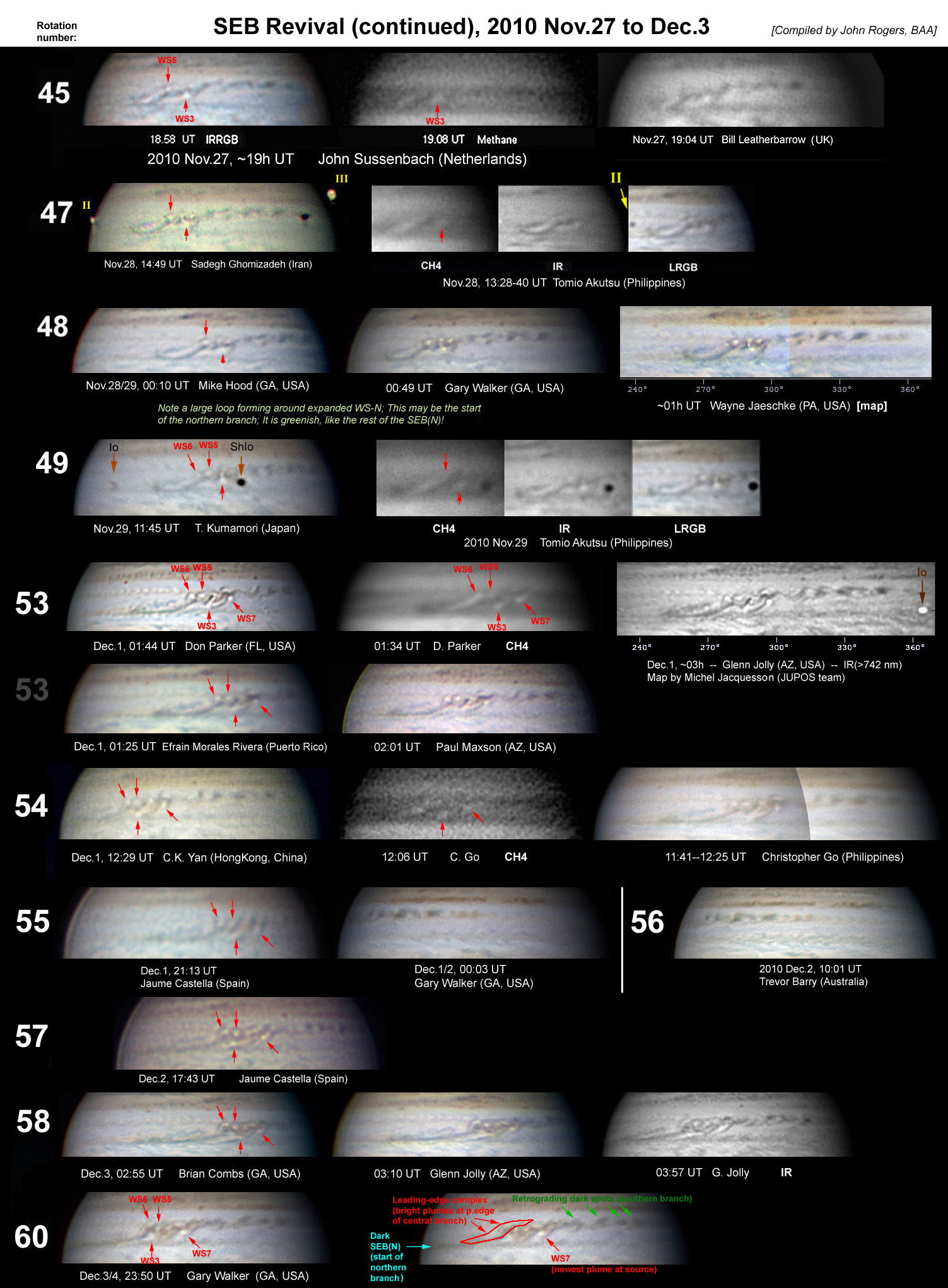| SEB Revival expanding (2010 Nov.27 to Dec.3) by John H.Rogers |
The SEB Revival is now proceeding vigorously in classical style, and all three 'branches' are becoming distinct. Attached is a fourth compilation of images of the SEB Revival, covering Nov.27 to Dec.3. New bright spots, also bright in methane images, appeared on Nov.29 (WS6, L2=280, in the leading edge complex) and Dec.1 (WS7, L2=298, at the original source). So far, all the bright spots have appeared in these two locations. A diagram of the outbreak is given at the bottom of the compilation.
Details of the major branches of the Revival during this period:
1) Source: WS7 was first imaged in visible light on Dec.1 (but on Nov.30 in infrared images by Dr Glenn Orton et al.). (NB: I referred to this as WS6 in earlier messages to some observers - apologies for any confusion.) WS3 had moved north; it was still very methane-bright up to Dec.1; but then it became entrained and distorted as it approached the SEBn jet and began prograding rapidly.
2) Central branch: A distinct 'leading edge complex' has formed, derived from the original plume (WS1) and 'dark column'. The latter is now an oblique dark streak, and on its p. side is an extended bright area derived from WS1, in which other bright (and methane-bright) plumes have repeatedly arisen: WS-N, WS4, WS5, and now WS6. The motion of the central branch is still rather slow: DL2 = -10 deg/month (DL3 = -2 deg/month) for WS1, WS-N, and WS3, according to JUPOS measurements just produced by Michel Jacquesson. WS5 had drifted south and so was slower-moving than the rest, and was still weakly methane-bright, up to Dec.1. WS6 appeared just p. it on Nov.29, much more methane-bright. Then WS6 moved south while WS5 moved north in a cyclonic swirl (Dec.1-3). There have been other, smaller and shorter-lived, bright spots in the same latitude from Nov.27 onwards.
On Dec.3, as observers have pointed out, the expanding disturbance is filling in with dark brown material. This may be the first sign of return of a 'normal' SEB region.
3) Northern branch: From Nov.29 onwards, the 'leading edge complex' began extending very rapidly at its Np. end. The old WS-N elongated and was surrounded by a large dark loop, comprising the original dark grey column on its Nf. side, a blue (and very methane-dark) streak on its Sp. side, and a dark greenish-grey streak on its N side. The latter streak has the same mysterious greenish-grey tint as the rest of the SEB(N), but is much darker, and is now elongating rapidly in the p. direction as a reviving segment of SEB(N). So this may be the emergence of the northern branch.
4) Southern branch:
There is now an impressive series of retrograding dark spots on SEB(S). I can send an additional compilation of images if wanted, aligned to track some of these spots. Speeds have not yet been measured, but some provisional results emerge from inspection of the images. There are key questions about how these spots form: in particular, what is their relation to the pre-existing 'sawtooth' or wave pattern on the SEBs, and is there any sign of vortices forming?
The sawtooth pattern is still clearly present p. and f. the Revival region, and some observers have commented that the dark material seems to be filling up the pre-existing projections. This seems to have been the case for the earliest spots, up to Nov.19 (although even then the pattern was not entirely stable as it passed the outbreak). There is still a trio of projections at the leading (western) end of the chain that appear to have been darkened in this manner. But then, another very dark spot emerged Sf. the source on Nov.19-21, and became the leading end of a sinuous dark SEB(S) which broke up into a chain of dark spots. These are larger, and more widely spaced, than the pre-existing projections (spacing 7-10 deg. for these dark spots, 6 deg. for the sawtooth pattern). By Nov.29, in addition, white spots from WS4 etc. have been disrupting the flow of the sawtooth pattern past the outbreak. So it appears that the larger dark spots replace the sawtooth pattern, in the same latitude (21 deg.S).
However they still seem to be formed by dark material filling spaces around bright spots, and there is complex, variable substructure. They have not yet formed distinct vortices. This is still expected to happen in the coming days. So, as of Dec.1, the retrograding chain begins with three darkened pre-existing projections at its western end, followed by four larger dark spots, followed by more chaotic dark material still emerging from the outbreak source region. Although they change shape rapidly, all these spots have maintained their identities since soon after they emerged.
Best wishes,
John
SEBO_Nov27-Dec3_labeld

John H. Rogers,Ph.D.
Jupiter Section Director,
[British Astronomical Association.]
●発達するSEB復活 (2010年11月27日〜12月3日) SEB復活は現在、古典的なスタイルで力強く進行していて、3個の分枝の全てが明瞭になっている。 添付したものは、11月27日〜12月3日の SEB復活の4番目の組画像である。新しい白斑はメタン画像でも明るく、11月29日 (WS6、L2=280度、先端複合体内に)と12月1日(WS7、 L2=298度、元の発生源で)に出現した。これまでのところ、全ての白斑は この2個の場所で出現している。outbreakの模式図を組画像の下部に示す。 ◆今期間中の復活の主要分枝の詳細 1) 発生源 12月1日にWS7が可視光で初めてとらえられた(しかし、Glenn Orton博士らによって11月30日に赤外画像でとらえられた)。 【注:私は何人かの観測者への前のメッセージでこれをWS6として参照した。混乱させて申し訳ない。】 WS3は北に移動した。12月1日まで非常にメタンブライトであった。しかし、その後SEBnジェット気流に接近すると、流れに 乗って歪み、急速に前進し始めた。 2) 中央分枝 元のプルーム(WS1)と暗柱に由来して、明瞭な"先端複合体"が形成された。現在、暗柱は斜めの暗いストリークであり、 その前端にはWS1に由来する拡がった明るい領域があり、そこではWS-N,WS4,WS5,WS6と明るいプルーム(メタンブライト)が 繰り返し出現している。中央分枝の動きはまだかなり遅く、Michel Jacquessonがちょうど作成したJUPOS計測によれば、 WS1,WS-N,WS3で DL2=-10度/月(DL3=-2度/月)である。 WS5は南にドリフトしたので、他よりもゆっくりと移動し、12月1日までなおも弱いメタンブライトであった。WS6は11月29日に WS5の前方に出現し、かなりメタンブライトであった。その後、WS6は南に移動したが、WS5は低気圧性渦を北に移動した(12月1-3日)。 11月27日以降、同じ緯度に他の小さな短命な白斑が存在した。 12月3日には、何人かの観測者が指摘したように、拡がった攪乱が暗茶色の物質で埋められている。これは"通常"のSEB領域への 復帰の最初の兆候かもしれない。 3) 北分枝 11月29日以降、"先端複合体"は北前方に急速に拡がり始めた。古いWS-Nは長く伸び、大きな暗いループに囲まれた。このループは、 北後端の元の暗灰色の暗柱と、南前端の青色ストリーク(非常にメタンで暗い)と、北端の暗緑灰色ストリークとから構成されて いる。北端のストリークはSEB(N) と同じ神秘的な緑灰色の色合いであるが、もっと暗く、現在SEB(N)の復活セグメントとして前方 に急速に伸びている。こうして、これが北分枝の出現かもしれない。 4) 南分枝 現在、SEB(S)には後退する見事な暗斑列がある。要望があれば、これらの暗斑を追跡するために整列した追加の組画像を送ることが できる。速度はまだ測定されていないが、画像の調査からいくつかの暫定的な結果が得られている。これらの暗斑がどのように形成 されているのかという重要な質問がある。特に、SEBsのすでに存在しているノコギリや波パターンとどのように関係しているか、 そして渦の兆候は形成されているか。 ノコギリ状のパターンは復活領域の前後に今も明らかに存在していて、何人かの観測者は暗物質が既存のプロジェクションを埋めて いるように思われるとコメントしている。これは11月19日までの最も初期の暗斑の場合であると思われる(outbreakを通過する時に、 パターンが全く安定していなかったとしても)。 このように暗くなったように見えるチェインの先端(西)には今も3連のプロジェクションがある。しかしその後、別の非常に暗い暗斑 が11月19-21日に発生源の南後方に出現し、暗斑に分解した曲がりくねった暗いSEB(S)の先端となった。これらは大きく、既存のプロ ジェクションよりも幅広く間隔を置いている(これらの暗斑で間隔7-10度、ノコギリ状パターンで6度)。さらに11月29日までに、 WS4等からの白斑がoutbreakを過ぎたノコギリ状パターンの流れを中断している。そのために同じ緯度(南緯21度)で大きな暗斑が ノコギリ状パターンを置き換えている。しかしながら、これらは白斑の周りの隙間を埋めている暗物質によって形成されているように 思われ、複雑で変化する部分構造がある。まだ明瞭な渦は形成されていない。数日中に起こると期待される。 こうして、12月1日現在、後退するチェインはその西端の3個の暗化した既存のプロジェクションで始まり、4個の大きな暗斑が続いて、 outbreakの発生源から今も出現している混沌とした暗物質が続いている。急速に形を変えているけれども、全ての暗斑は出現した直後 から識別できている。John H. Rogers, Ph.D. Jupiter Section Director, British Astronomical Association 【日本語訳:伊賀祐一】
ALPO-Japan Latest
Jupiter Section